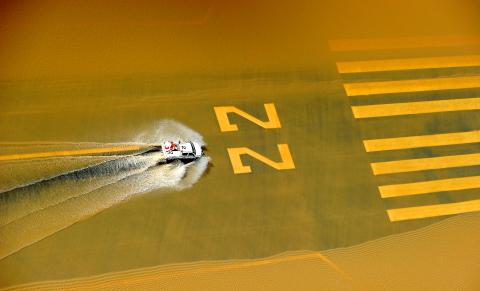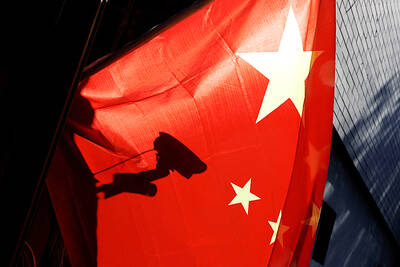Australia’s record floods are causing catastrophic damage to infrastructure in the state of Queensland and have forced 75 percent of its coal mines, which fuel Asia’s steel mills, to grind to a halt, Queensland’s premier said yesterday.
The worst flooding in decades has affected an area the size of Germany and France, leaving towns virtual islands in a muddy inland sea, devastating crops, cutting major rail and road links to coal ports, slashing exports and forcing up world coal prices.
“Seventy-five percent of our mines are currently not [in] operation because of this flood,” Queensland Premier Anna Bligh told local television. “So, that’s a massive impact on the international markets and the international manufacturer of steel.”

PHOTO: AFP
The floods, which have cut off 22 towns and affected 200,000 people, have resulted from the La Nina weather phenomenon, which produces monsoonal rains over the western Pacific and Southeast Asia.
La Nina is expected to last another three months after it produced Australia’s third-wettest year on record last year, the nation’s weather bureau said yesterday.
“Queensland is a very big state. It relies on the lifelines of its transport system, and those transport systems in some cases are facing catastrophic damage,” Bligh said. “Without doubt this disaster is without precedent in its size and its scale here in Queensland. What I’m seeing in every community I visit is heartbreak, devastation.”
Residents in flooded towns scrambled to build sandbag levees yesterday in the hope of holding back the rising waters, which analysts estimate could shave around 0.4 percentage point of Australia’s economic activity.
In Rockhampton, a cattle town of 75,000, a rise of just 20cm in floodwaters would inundate another 400 homes and lap at the front door of a further 4,000 properties.
“Let’s hope we dodge the bullet. Every centimeter counts,” said Ian Stewart, Queensland’s state disaster co-ordinator.
Three people have drowned in the floods. Authorities are warning people to stay out of floodwaters not just because of the risk of drowning but because snakes and crocodiles are being washed into homes and shops.
Some coal mines in Queensland, the world’s biggest exporter of coal used in steel-making, were resuming production although the outlook remained uncertain.
Macarthur Coal said yesterday it had resumed transporting coal by rail to Dalrymple Bay Coal Terminal this week, but force majeure notices remained in place and future coal trains would depend on coal availability.
“Once the pits are free of water, we’ll have more coal exposed that can be processed and transported,” Nicole Hollows, Macarthur’s managing director, said. “It is not possible to predict when we will return to a steady state of mining as that largely depends on any future rain.”
Wesfarmers is resuming output at its Curragh mine in the Bowen Basin, but maintained its force majeure.
A spokesman for Dalrymple port warned that unless mine companies resume production in the nation’s biggest coal region soon, coal export shipments could again be cut.
Some rail lines carrying coal from inland mines expected to stay partially underwater for another week.
“In terms of river levels, they might recede by next week, but these big mining establishments are obviously going to feel the affects for months to come,” said Jess Carey, a flood forecaster for the Australian Bureau of Meteorology.
Coal mines with annual production capacity of more than 90 million tonnes have issued force majeure notices, which release them from delivery obligations.

A magnitude 7.0 earthquake struck off Yilan at 11:05pm yesterday, the Central Weather Administration (CWA) said. The epicenter was located at sea, about 32.3km east of Yilan County Hall, at a depth of 72.8km, CWA data showed There were no immediate reports of damage. The intensity of the quake, which gauges the actual effect of a seismic event, measured 4 in Yilan County area on Taiwan’s seven-tier intensity scale, the data showed. It measured 4 in other parts of eastern, northern and central Taiwan as well as Tainan, and 3 in Kaohsiung and Pingtung County, and 2 in Lienchiang and Penghu counties and 1

A car bomb killed a senior Russian general in southern Moscow yesterday morning, the latest high-profile army figure to be blown up in a blast that came just hours after Russian and Ukrainian delegates held separate talks in Miami on a plan to end the war. Kyiv has not commented on the incident, but Russian investigators said they were probing whether the blast was “linked” to “Ukrainian special forces.” The attack was similar to other assassinations of generals and pro-war figures that have either been claimed, or are widely believed to have been orchestrated, by Ukraine. Russian Lieutenant General Fanil Sarvarov, 56, head

FOREIGN INTERFERENCE: Beijing would likely intensify public opinion warfare in next year’s local elections to prevent Lai from getting re-elected, the ‘Yomiuri Shimbun’ said Internal documents from a Chinese artificial intelligence (AI) company indicated that China has been using the technology to intervene in foreign elections, including propaganda targeting Taiwan’s local elections next year and presidential elections in 2028, a Japanese newspaper reported yesterday. The Institute of National Security of Vanderbilt University obtained nearly 400 pages of documents from GoLaxy, a company with ties to the Chinese government, and found evidence that it had apparently deployed sophisticated, AI-driven propaganda campaigns in Hong Kong and Taiwan to shape public opinion, the Yomiuri Shimbun reported. GoLaxy provides insights, situation analysis and public opinion-shaping technology by conducting network surveillance

‘POLITICAL GAME’: DPP lawmakers said the motion would not meet the legislative threshold needed, and accused the KMT and the TPP of trivializing the Constitution The Legislative Yuan yesterday approved a motion to initiate impeachment proceedings against President William Lai (賴清德), saying he had undermined Taiwan’s constitutional order and democracy. The motion was approved 61-50 by lawmakers from the main opposition Chinese Nationalist Party (KMT) and the smaller Taiwan People’s Party (TPP), who together hold a legislative majority. Under the motion, a roll call vote for impeachment would be held on May 19 next year, after various hearings are held and Lai is given the chance to defend himself. The move came after Lai on Monday last week did not promulgate an amendment passed by the legislature that